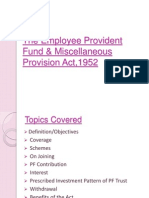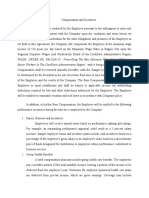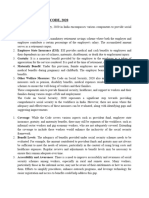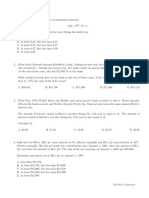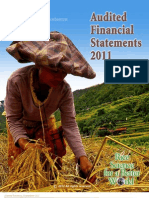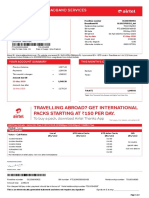Pension As A Retirement Benefit
Pension As A Retirement Benefit
Uploaded by
Prashant SharmaCopyright:
Available Formats
Pension As A Retirement Benefit
Pension As A Retirement Benefit
Uploaded by
Prashant SharmaOriginal Title
Copyright
Available Formats
Share this document
Did you find this document useful?
Is this content inappropriate?
Copyright:
Available Formats
Pension As A Retirement Benefit
Pension As A Retirement Benefit
Uploaded by
Prashant SharmaCopyright:
Available Formats
Retirement Planning
In view of the need for regular income to support an employee during his
retired life, it is necessary that the pension should be continuing upto his
death.
Further, a reduced pension should be available for his widow if she survives
the employee and even can be extended to the child till he/ she become
major in spouse also die after wards.
Alternatively, the employee, in lieu of can opt for a pension payable to him for
a life time with a guaranteed payment for a period ranging from 5, 10 or 15
years.
In case of lump sum need immediate after retirement, it is possible to
commute a portion of the pension for a lump sum as provided under rule 90
of the Income Tax Rules, 1962.
Under this rule one third of the total pension can be commuted if gratuity is
separately received by the employee and if no gratuity is received, then one
half of the pension can be commuted.
The concept of pension payable after retirement was brought to India by
Britishers during their rule. During their rule a non contributory pension
scheme was introduced as a service benefit for the govt. employees.
Under the scheme, the pension is earned on retirement from govt. service
and is related to the number of qualifying years of service and average
emoluments.
The minimum and maximum qualifying services are twenty years and thirty
three years respectively.
The pension will be determined in proportion to maximum admissible pension
as the qualifying service rendered bears to thirty three years.
The average emoluments drawn during the last ten months of service, shall
comprise of basic pay and will be determinant factor.
The amount of pension is determined as follows:
(i) Upto to first Rs. 1000/- of average emoluments ……50% of average
emolument
(ii) Next Rs. 500/- of average emoluments…………… 45% of average
emoluments
(iii) Balance of average emoluments………….. 40% of average
emoluments
In addition, the employee is entitle to relief which is about 30% of the basic pension
with a minimum of Rs. 25/- and a maximum of Rs. 150/- p.m.
An employee pension depends upon his average emoluments, qualifying
service and the amount of relief. This is subject to review from time to time
depending on the change in the average cost of index level.
Commutation of pension for lump sum is permitted to the extent of 1/3 rd of
the pension at the time of retirement.
The amount of family pension is determined as per the following table:
Prashant Sharma Page 1
Emolument of Employee Amount of Pension Minimum Maximum
Below Rs. 400/- 30% of emolument Rs. 60/- Rs. 100/-
Rs. 400 to 1200/- 15% of emolument Rs. 100/- Rs. 160/-
Rs. 1200 and above 12% of emolument Rs. 160/- Rs. 250/-
In addition, the family pensioner is given relief at the rate of 50% of the basic
family pension, subject to a maximum of Rs. 250/- per month. In case the
employee dies while in service or within seven years of his retirement the
pension will be double the rate for the period of seven years or till the
employee would have reached his sixty-fifty birthday.
During the pre-independence period, the foreign companies transacting
business in India were also granting pension on selecting basis of their senior
officers. In some cases, the pension benefits were available to all the
employees right from sub staff to senior executives.
All these benefits are charged on the total income of the employer. The
pensionary benefits can be provided separately or it can be added in the
salary to create a pension fund in both the situation, pension benefit should
not stop on the death of the pensioners if it occurs few years after retirement.
In that event, the spouse and other family members who are dependent on
him shall suffer. In order to avoid such a situation, the pension must be
guaranteed for a certain period of time so that the pension benefit must
continue in case early death of the pensioner after the pension starts coming
to him.
In view of the social conditions prevailing in our country, employees generally
prefer lump sum benefits, but in case of high salaried employees pension is
taken as an additional benefit.
This led to the evolution of Provident Fund, which provides lump sum
payment as service benefit on retirement or death or ceasation of service.
Provident benefits can be available as per the laid down conditions under the
provision of EPF and Misc. Provision Act 1952. The employee and the
employee has to make a contribution to this fund which should be set up as
per the Income Tax Act 1961. When the fund is so constituted it will have the
recognition and will have the benefit of I.T. relief.
Gratuity is another lump sum benefit to the employees conferred by the
payment of Gratuity Act 1972. Provident Fund and Gratuity have now become
compulsory in industrial undertakings and the pension shall be only as a
supplementary benefit to the employees.
The combination of all these benefits may help the employees to meet the
needs of capital expenditure such as repayment of housing loan, marriage or
higher education of children.
The pension as retirement benefit in this way shall remain intact if guaranteed
as a statutory benefit by way of legislation.
Different ways of Arranging Schemes
Prashant Sharma Page 2
There are various alternative methods available for settling up of a
superannuation scheme for the purpose of making provision of those benefits
to the employees and their dependents.
Payments by employer
Majority of the employer do not want to undertake any responsibility to pay
pension to their employees because of long term commitments.
Some of the employers who are progressive minded do give some reward to
some employees who have made significant contribution for the success of
the business by rendering long and meritorious service. This is done by a
board resolution deciding to grant a pension for a specified amount to the
concerned employees.
The recurring liability on this amount need not be funded and can be paid out
by charging the current revenue of the employer.
In order to secure the financial commitment, it would be essential for the
employee to purchase an immediate annuity policy from an insurance
company by paying required amount of premium.
Payment of pension by the employer out of current revenue is generally not a
satisfactory method.
According to sound financial principles, the pension liability incurred in a
particular year should be met in that year only and adequate financial
provision should be made every year for meeting the liability under this
method.
The drawbacks in making payment of lump sum benefit out of the current
revenues of the company shall be as follows:
(i) That the lump sum drawn in a particular year shall decrease the
profit of the company for that year.
(ii) The number of pensioners may increase in years to come which
shall further put heavy burden on the profits of the company.
(iii) There may be a possibility that the company may run into a loss in
some particular year and offering these benefits would be great
problem.
(iv) The company shall not be able to avail of the tax benefits every
year.
(v) In such situation the pension benefits can be reduced or even
denied if the profitability of the company is not good enough to pay
these benefits.
Funding through Trust
For introducing a superannuation scheme the employer can make use of the
medium of Trust for funding his pension liability.
The organization/ employer has to create Trust and appoint at least two
trustees to manage the fund.
The contribution to the trust fund both by the employers and the employees
are paid into it.
Prashant Sharma Page 3
The appointed Trustee shall have the sole power to manage the trust fund
and it will be their responsibilities to invest the fund in the manner prescribed
by the revenue authorities and secure the pensions for the members when it
become due.
The fund will have to be approved by the commissioner of Income Tax under
part B of the fourth schedule of I.T. Act 1961.
This method of funding the pensions affords complete security to the
employees in respect of future pension payments.
The following two alternatives are available to the Trustees for managing the
Trust.
(i) To inter into a scheme of insurance and pay the contribution
received from the employer for securing pension benefit or
(ii) To accumulate the contribution in approved investment and to
purchase the annuities for the members from an insurance company
as and when pensions become payable to the particular employees.
Insured Schemes
After setting up of the Trust Fund, the Trustees can enter into a group
superannuation scheme with the Insurance Cos., which shall help the
Trustees for not having botheration of managing and administering of the
fund.
The insurance co. by accepting the contribution, shall insure the pension by
issuing a master policy to the Trustees to cover all the members of a scheme.
The contribution can be percentage of the employees salary that may be used
to buy a pension for them or.
If the pension is predetermined, then the contribution will be determined on
an actuarial basis. In such a provision, the rate will have to be reviewed from
time to time so that the relationship between the contribution and the value
of benefits to be paid in future be maintained.
In such a scheme, the pension benefits shall be paid directly to the retiree
employee subject to the written authority from the trustees in this
connection.
The premium and annuity rates are determined after estimating the rate of
interest and the return in the investment made under superannuation fund
schemes.
The investment of the fund under such schemes are governed by the IRDA
Regulation, where large percentage of the funds i.e. up to 50% have to be
invested in central and state govt. securities and the balance can be invested
in debenture and loans to public sector companies.
Trustees Administered Schemes
In administering the fund by the Trustees themselves, they will have to invest
the fund according to the pattern prescribed by the central board of direct
taxes.
The Trustees have to administer the fund with utmost efficiency in order to
have the maximum return.
Prashant Sharma Page 4
In addition to this, there are required to invest the contribution, purchase &
selling of securities, collection of interest obtaining tax exemption from the
concerned authorities, maintenance of books of accounts and other relevant
records.
Above all, the Trustee are required to ensure full safety of the funds and
should make available liquid funds for purchasing pension from the insurance
co.
In providing the specified amount of pension the Trustees would require the
help of qualified actuary to review and for valuing the liability and
determining the rate of contribution to ensure solvency of the fund.
While making an estimate of contribution, the actuary will take into
consideration various factors such as expected return of investment, future
years of service, increases in salaries, mortality and turn over rate of
employees etc
Even after taking all these factors into consideration and observing all
possible care and precaution, there is always a danger that at some future
date the fund may not be sufficient to provide full benefits.
In such a scenario either the benefits will have to be reduced or the rate of
contribution will have to be increased with in the prescribed limit or it can be
apposite if the fund position is quite good beyond expectation. It will depend
on the pattern of investments prescribed from time to time by central board
of direct taxes in case of Trustees administered funds.
Comparison of Trustee Administered Fund Schemes vis-à-vis Insured
Schemes: Advantages & Disadvantages?
In case of Trustees administered fund, the Trustees themselves can not pay
the pensions out of superannuation fund, but have to purchase an annuity
from the Insurance co. to enter into a scheme of insurance with the Insurance
co.
The Trustees can administer this fund till the contingencies arise, for payment
of pension. When the pension has to commence. The Trustees have to realize
the accumulation to pay to the insurance co. to buy the desired amount of
annuity who in them will undertake to provide the stated amount of pension
through out the lifetime of the employee.
The insurance co. has the expertise to deal with various type of problems
arising in administering a pension scheme.
They have an advantage of large number of staff having wide experience and
expertise, which helps to invest the funds for better return.
It also helps to reduce the cost of funding by having the services of office
actuary, legal advisor and investment professional, which facility is not
available in Trustees administered funds.
The insurance scheme is advantageous in case of small cos., where the no. of
employees are much less and consequently the funds for investment will also
be much smaller.
The Trustees, being individuals and funds available being limited, it would be
rather difficult to earn high yield to justify self administration.
Prashant Sharma Page 5
If the co. is having large number of employees, the administration of funds by
the trustees may be justified as they may have large amount of funds to be
invested and can also take the help of staff members in administering the
funds which may reduce the cost of administering the funds.
It is often said that insurance schemes are rigid or less flexible than the
trustee administration scheme, where as the trustees administered schemes
are more flexible.
In the trust administered fund, the trustees can think of providing more
additional benefits like disablement pension, discretionary pension, early
retirement pension and ill health retirement pension etc.
These additional benefits are not possible under insured schemes as the
restricted to pension dependent on life. If the employer wants to provide to
an employees widow a pension which ceases on death or earlier remarriage.
The insurance company may not be writing to allow for the probability of re-
marriage in the calculations.
In case of insurance scheme, the face of funding is slow, where as the face of
funding in case of trustee administered fund can be faster but shall depend on
the circumstances obtaining year after year.
The rigidity factor in the insured schemed has now been modify by
introducing a newly devised deposit administration technique by ‘cash
accumulation’ system. It has thus been able to provide all the favorable
features of a trustee administered scheme. It also retrieves the trustee of the
botheration of investment problems. It also helps the corporation to same
administrative cost which is passed on to the trustees in the form of higher
interest.
In insured scheme, the insurance co. gives guarantee of premium and annuity
rates and even investment risk by transferring the risk from the employer to
the insurance co.
The payment of pension is found to be more service of managed with the help
of insurance co.
In the end, the insured schemes relieve the trustees from lot of
administration work required for management of investment of fund,
providing greater security and is definitely better than self administered fund
even if it is little costlier to the trustees.
How to set up superannuation schemes?
To set up a superannuation scheme, the employer has to take some of the
basic decisions ie. (1) who will participate? (2) who should contribute, the
employer, the employer or both? (3) the rate of contribution or the scale of
pension to be provided or (4) whether it should be administered by the
trustees or by Insurance Company?
The answers to the above will indicate the type of scheme of be adopted.
The scheme can be adopted according to the status of employee and the
benefits provided in the organization.
The scheme that are adopted may be suitable to a high paid employee and
the some may not be suitable to a low paid employee.
Prashant Sharma Page 6
The very fact why it will not suit is that majority of them will not stay for long
in the organization and has a high rate of turnover.
The success of any such scheme will depend on the amount of contribution
and the benefits provided.
Some of the benefits are compulsory retirement benefits which are the force
of law and have to be provided by the employer.
Therefore, the scope for finding additional financial resources is restricted to
rearranging other existing benefits.
How to Manage Financial Resources
To make provision of pension one such source is the profit of the employer or
It can be shared between the employer and the employee in a specified
proportions.
If the employer, while feeling the inevitability of giving pension, does not
make advance provision, he is ignoring one of his accruing costs and thus
undercharging his customers or overestimating his projects.
Since pension forms part of service benefits, the scheme can not be set up
without employers participation other wise it will not have the tax benefits.
The LIC also stipulates participation by the employer and insists that the
contribution by the employer should not be less than 25% of the total
contribution payable under the scheme.
The idea behind the participation by the employer is to ensure that he may
acquire ownership of the scheme and its successful operation.
In case the scheme is contributory by the employer and the employee, it is
matter of re-arranging the total salary package which may compose of cash
benefits and certain other perquisites.
In order to have tax benefits, the employees can forgo some percentage of
the cash benefits and contribute to the superannuation scheme and get it as
pension and retirement.
Since the pension benefits are not obligatory on the part of the employer,
therefore, the employer will not take the initiative to introduce and make a
contributions over and above the statutory provisions that are required.
In the case of highly paid employees and incidence of tax is very heavy,it
would always be proper to forgo a part of their benefits to contribute to the
superannuation scheme.
The pension when received will be taxable but the incidence of tax after
retirement shall be much less.
In another situation where the employees are paid bonus every year in
addition to the annual salary and perks where the monthly basic salary of
such employees is below 6500/-. Those employees who are not covered
under the bonus Act, the employer can think of compensating these
employees and senior executives by contributing to the super annuation fund
and payable as pension on retirement.
Non-Contributory Scheme
Prashant Sharma Page 7
A scheme under which the employer alone contributes is called a ‘non-
contributory scheme’.
The contribution is wholly made by the employer according to the type of
benefits. If the benefits are predetermined, than an amount equal to get
these fixed benefits, has to be contributed every month.
On the other hand, if the contribution is fixed as a percentage of salary, then
a regular contribution as a percentage of the salary has to be contributed by
the employer every month.
Under the superannuation scheme, there is provision to provide benefits for
the past services rendered by the employees before the installation of the
scheme.
These contribution can be paid either in lump sum or by installment spread
over a specified number of years.
Alternatively, it can also be purchased by level annual contribution payable
throughout the future service of the employee.
Under non-contributory schemes, the insurance companies generally insist
upon 100% participation by all eligible employees.
In this connection, the employer is free to stipulate any minimum service
conditions to make them eligible for pension.
The insurance company usually insist yearly mode of payment of premium
and the contribution should not exceed the upper limit of 27% of the salary of
the employee less the employers contribution to provident find in respect of
the employees for each year of service.
When the scheme is non-contributory, the employer will always try to keep
the cost of this benefit at the minimum so, it would be prudent on the part of
employer to fund the pension under any plan which fulfills this requirement.
The insurer in such case always recommend without return defused annuity
plan for securing the pension.
If the employee withdraws from the scheme as a result of cessation of
service, it is the practice of the insurance co. to pay a surrender value
equivalent to major part of the premium received.
Under such scheme there is a provision to provide death benefit in case the
concerned employee dies during service period.
The non-contributory scheme has certain advantages, it is simpler and easy
to administer as does not require deduction from employees salary.
Contributory Scheme
A ‘contributory scheme’ is one in which the employees also make a
contribution.
Employees contribution is expressed as a percentage of his salary.
Under the schemes, where contributions are fixed, the employees and
employers contributions will be stated in terms of percentages of the salary of
employee.
This amount will be directly applied to secure whatever pension can be
purchased for each employee.
Prashant Sharma Page 8
In case of schemes which offer specified pension, first of all the employees
contribution, shall be applied to secure past of pension. The remaining part of
the pension will be paid for by the employer and as such the employer’s
contribution will have to be determined for each employer.
In contributory schemes, it will be necessary for the employer to deduct the
employees contributions from them salaries and resist to the trustees.
The mode of payment to the insurer is yearly, in such cases, the employer
may advance the employees contributions payable for a year and recover the
same by deductions form the salaries every month.
It, for any reasons, the employers do not agree to this course, then the
premiums may be paid in monthly installments. In either case, the employer
must obtains written authority from the employees for the deduction of
contribution from their salaries.
Under the contributory scheme, it is the usual practice to apply under-return
deferred annuities schemes.
*****
Prashant Sharma Page 9
You might also like
- Offer LetterDocument14 pagesOffer LetterPramod KumarNo ratings yet
- Inside Bar TradingDocument165 pagesInside Bar TradingBhavik Patel100% (2)
- Business Plan Glass ShopDocument32 pagesBusiness Plan Glass ShopJames ZacharyNo ratings yet
- Ac Standard - AS15Document9 pagesAc Standard - AS15api-3705877No ratings yet
- Funds Section: Section. The Criteria of Payment For The Final Settlement IncludeDocument5 pagesFunds Section: Section. The Criteria of Payment For The Final Settlement Includemohsin_111No ratings yet
- BENEFITS - Pension SchemeDocument9 pagesBENEFITS - Pension SchemeajaygaekwadNo ratings yet
- Twelve Point Pension Reform PlanDocument4 pagesTwelve Point Pension Reform PlanGregory Flap ColeNo ratings yet
- GailDocument19 pagesGailAbc DNo ratings yet
- SBF Iocl 19.11.12Document18 pagesSBF Iocl 19.11.12ParameshNo ratings yet
- Applicability of Provident Fund Act and Pension Scheme On International Workers (Post Amendment)Document7 pagesApplicability of Provident Fund Act and Pension Scheme On International Workers (Post Amendment)penusilaNo ratings yet
- Defined Benefit Pension PlanDocument8 pagesDefined Benefit Pension Planhenok AbebeNo ratings yet
- IC 83 - Compressed-5Document50 pagesIC 83 - Compressed-5purnachandrashee1No ratings yet
- TCS - OfferLetterDocument11 pagesTCS - OfferLetterSai KrishnaNo ratings yet
- Contributory Pensions SchemeDocument9 pagesContributory Pensions SchemeMohammed Ibrahim AdogaNo ratings yet
- IC 83 - Compressed-1Document50 pagesIC 83 - Compressed-1purnachandrashee1No ratings yet
- IC83Document359 pagesIC83Mani BhushanNo ratings yet
- Provident FundDocument9 pagesProvident FundYogesh KandariNo ratings yet
- PF SchemeDocument5 pagesPF SchemeVelayudham ThiyagarajanNo ratings yet
- Salient Features of The Employees Provident Funds and Miscellaneous Provisions Act, 1952Document3 pagesSalient Features of The Employees Provident Funds and Miscellaneous Provisions Act, 1952Fency Jenus80% (5)
- Lecture-2 Employees' Provident Funds and Miscellaneous Provisions Act, 1952Document7 pagesLecture-2 Employees' Provident Funds and Miscellaneous Provisions Act, 1952lakshmikanthsrNo ratings yet
- 502 Sem ExamDocument25 pages502 Sem ExamMotilal JaiswalNo ratings yet
- Group Saving Linked Insurance SchemeDocument14 pagesGroup Saving Linked Insurance SchemeSam DavidNo ratings yet
- Retirement Planning: by Prof Sameer LakhaniDocument18 pagesRetirement Planning: by Prof Sameer LakhaniPooja DeliwalaNo ratings yet
- Provident Fund ActDocument14 pagesProvident Fund ActAkanksha Dubey0% (1)
- BY Bipender GuptaDocument23 pagesBY Bipender GuptaDr-Shefali GargNo ratings yet
- Human Resource Department: by J.A.V.R.N.V.PRASADDocument28 pagesHuman Resource Department: by J.A.V.R.N.V.PRASADAmarnath VuyyuriNo ratings yet
- OfferLetter PDFDocument11 pagesOfferLetter PDFNaveen GaneshNo ratings yet
- Pension Plans in India NEWWDocument22 pagesPension Plans in India NEWWKomal BhatiaNo ratings yet
- EPF ActDocument10 pagesEPF ActManpreet Kochhar100% (1)
- A Dissertation Report ON Employee'S Pension OF Tata Steel LimitedDocument19 pagesA Dissertation Report ON Employee'S Pension OF Tata Steel LimitedSimran SrivastavaNo ratings yet
- Overview of Retirement and Social Security Benefits: Presented By: Jehangir DaruvallaDocument13 pagesOverview of Retirement and Social Security Benefits: Presented By: Jehangir Daruvallafrenz2kiranNo ratings yet
- Provident Fund FAQDocument4 pagesProvident Fund FAQgodsthomachayanNo ratings yet
- PF & Miscellaneous Provisions ActDocument19 pagesPF & Miscellaneous Provisions Actpriya_ammuNo ratings yet
- Pension Fund and Provident FundDocument17 pagesPension Fund and Provident FunddarshankumartoliaNo ratings yet
- EPFODocument29 pagesEPFOPratham sharmaNo ratings yet
- The PF Act, 1952Document16 pagesThe PF Act, 1952Sonam SinghNo ratings yet
- Labour Laws 10Document11 pagesLabour Laws 10dskrishnaNo ratings yet
- Overview of Retirement and SocialDocument13 pagesOverview of Retirement and SocialRukeshNo ratings yet
- Compensation and IncentivesDocument2 pagesCompensation and IncentivesLuis WashingtonNo ratings yet
- Labour LawDocument14 pagesLabour LawRiya SharmaNo ratings yet
- Unit 4 Retirement BenefitsDocument4 pagesUnit 4 Retirement BenefitsPrashni KathuriaNo ratings yet
- Social Security System Under Labour Act, 2048 (1992)Document4 pagesSocial Security System Under Labour Act, 2048 (1992)Prashant SharmaNo ratings yet
- Offer LetterDocument17 pagesOffer LetterManu SavioNo ratings yet
- Pension FundDocument22 pagesPension FundsyilaNo ratings yet
- Ir NotesDocument15 pagesIr Notesavisha354No ratings yet
- Provident FundDocument6 pagesProvident Fundalan finianNo ratings yet
- Offer LetterDocument19 pagesOffer LetterMukesh YadavNo ratings yet
- EPF ActDocument22 pagesEPF ActRajeshNo ratings yet
- Presentation On PF Misc Provision Acts 1952Document45 pagesPresentation On PF Misc Provision Acts 1952puja_05100% (2)
- EpfoDocument33 pagesEpfoSHRISHTI SINGH100% (1)
- COMP Speaker NotesDocument3 pagesCOMP Speaker NotesAnupriyaNo ratings yet
- Asset Management-Pension FundsDocument9 pagesAsset Management-Pension FundsKen BiiNo ratings yet
- PRMS FAQsDocument3 pagesPRMS FAQsfriendbceNo ratings yet
- Assignment of Research Methodology ON Voluntary Retirement SchemeDocument14 pagesAssignment of Research Methodology ON Voluntary Retirement SchemeParina JainNo ratings yet
- Employees Provident Fund & Miscellaneous Provision Act, 1958Document10 pagesEmployees Provident Fund & Miscellaneous Provision Act, 1958Maulik VoraNo ratings yet
- Reading Material - EPF Act, 1952Document4 pagesReading Material - EPF Act, 1952Kaushik BoseNo ratings yet
- Personal FinanceDocument10 pagesPersonal Financehariom gargNo ratings yet
- Employees Provident Fund (And Miscellaneous Provisions) Act, 1952Document30 pagesEmployees Provident Fund (And Miscellaneous Provisions) Act, 1952Rahul ChintaNo ratings yet
- Income From SalaryDocument21 pagesIncome From SalaryAditya Avasare60% (10)
- Setting up, operating and maintaining Self-Managed Superannuation FundsFrom EverandSetting up, operating and maintaining Self-Managed Superannuation FundsNo ratings yet
- ACS Results Report 2022Document41 pagesACS Results Report 2022RickyNo ratings yet
- Easy To Pay Centogene": 1. Payment by Bank TransferDocument2 pagesEasy To Pay Centogene": 1. Payment by Bank TransferEh MohamedNo ratings yet
- A.1.2 ProblemsDocument2 pagesA.1.2 ProblemsOmer ShareefNo ratings yet
- BOA Syllabus MASDocument3 pagesBOA Syllabus MASElizabeth YgotNo ratings yet
- AFMDocument213 pagesAFMAnkita SainiNo ratings yet
- Article - Shefali Goradia - Jul 121341305754Document9 pagesArticle - Shefali Goradia - Jul 121341305754Alok Kumar ShuklaNo ratings yet
- Sample CLBG ConstitutionDocument33 pagesSample CLBG ConstitutionMohamad Jamarul Rasol (Jem)No ratings yet
- DPE Guidelines On Corporate GovernanceDocument47 pagesDPE Guidelines On Corporate GovernanceGautamSinghNo ratings yet
- Primary Source AnalysisDocument3 pagesPrimary Source AnalysisLuke GarciaNo ratings yet
- Checklist Housing LoanDocument2 pagesChecklist Housing LoanJulius LuzonNo ratings yet
- Top Chart Traders - Insider Tips - Best High Performance Indicators PDFDocument133 pagesTop Chart Traders - Insider Tips - Best High Performance Indicators PDFlior199No ratings yet
- CH 24Document28 pagesCH 24lbengtson1100% (1)
- SFS Facts FiguresDocument21 pagesSFS Facts FiguresShwetha IyerNo ratings yet
- Assignment 1 Corporate Finance (FIN201: Deadline For Students: (13/10/2022@ 23:59)Document12 pagesAssignment 1 Corporate Finance (FIN201: Deadline For Students: (13/10/2022@ 23:59)saidNo ratings yet
- IRRI AR 2011 - Audited Financial StatementsDocument45 pagesIRRI AR 2011 - Audited Financial StatementsIRRI_resourcesNo ratings yet
- Case Digest Nego My CaseDocument2 pagesCase Digest Nego My CaseKIM COLLEEN MIRABUENANo ratings yet
- Sobha Limited Q1 FY2020 Post Results Conference CallDocument18 pagesSobha Limited Q1 FY2020 Post Results Conference Calltarun lahotiNo ratings yet
- Canara - Statement - 2024-06-28 12 - 06 - 08.708598Document60 pagesCanara - Statement - 2024-06-28 12 - 06 - 08.708598shivaay.pjNo ratings yet
- 6.3. Flags: Trade Chart Patterns Like The ProsDocument6 pages6.3. Flags: Trade Chart Patterns Like The Prospudiwala100% (1)
- Fixedline and Broadband Services: Your Account Summary This Month'S ChargesDocument2 pagesFixedline and Broadband Services: Your Account Summary This Month'S ChargesLalit SharmaNo ratings yet
- Corporate Governance: Accountants and AuditorsDocument22 pagesCorporate Governance: Accountants and AuditorsVam EnzioNo ratings yet
- Leverage QuestionsDocument8 pagesLeverage QuestionsMidhun George VargheseNo ratings yet
- High Court of Chhattisgarh District & Sessions Court, RaipurDocument3 pagesHigh Court of Chhattisgarh District & Sessions Court, RaipurVirat VermaNo ratings yet
- Accounting Standard Board of IndiaDocument5 pagesAccounting Standard Board of IndiaRajat ChauhanNo ratings yet
- Who Is Liable To Make The PaymentDocument4 pagesWho Is Liable To Make The PaymentCJ CorpuzNo ratings yet
- Orange Resume Template-WPS OfficeDocument2 pagesOrange Resume Template-WPS OfficeMaria Cristina GornezNo ratings yet
- Chapter 01Document4 pagesChapter 01JpzelleNo ratings yet
- Syllabus LPM - PGDocument13 pagesSyllabus LPM - PGRAHULNo ratings yet



































